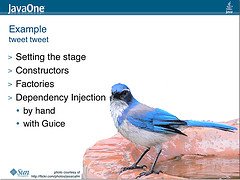I dig the Creative Commons
Joe Clark, author of a fantastic book on Canadian English and a childish rant about Google employees is at it again. This time he's planning a book about how copyright benefits creative people:Who’s sticking up for the individual creator? Neither side is. The maximalist side wants to collect as many copyrights under a corporate umbrella as possible, guarding them forever. The minimalist side wants you to voluntarily surrender most of your important rights – also forever – on the off chance that “the culture” might someday wish to use your work.
I read Mark Helprin's Digital-Barbarism on the same topic. That book was entertaining, but it's more of an old man's rant than a reasoned argument. I assume Mr. Clark will be more disciplined, and read about copyright before he starts to write about copyright.
One premise of the new book is that creative commons is a bad idea. You sign up for creative commons because of peer pressure and don’t even know what you’re signing away. Naturally I feel compelled to share some counter examples that demonstrate the benefit of creative commons, from both sides of the copyright transaction.
As a creative person
 While in highschool, I created a few dozen fonts and gave them away under a liberal license (creative commons didn't exist in 1997). I created the fonts because I enjoyed doing so, not because I wanted to become the next Britney Spears of fonts. By lowering the cost of using my fonts (to zero!), their use increased. There are great websites organized around sharing free fonts. As a consequence, I get to see my creative works in the wild. I've seen 'em in everything from video games to tattoos. One reason people prefer my fonts over the esthetically superior commercial ones is that they don't need permission to use mine!
While in highschool, I created a few dozen fonts and gave them away under a liberal license (creative commons didn't exist in 1997). I created the fonts because I enjoyed doing so, not because I wanted to become the next Britney Spears of fonts. By lowering the cost of using my fonts (to zero!), their use increased. There are great websites organized around sharing free fonts. As a consequence, I get to see my creative works in the wild. I've seen 'em in everything from video games to tattoos. One reason people prefer my fonts over the esthetically superior commercial ones is that they don't need permission to use mine! As a consumer of creative works
 Recently I've been giving tech talks at conferences. I get bored by text-only slides, so I've made my own presentation more interesting with pictures. For example, when explaining the
Recently I've been giving tech talks at conferences. I get bored by text-only slides, so I've made my own presentation more interesting with pictures. For example, when explaining the Provider abstraction, I like to show a Pez Dispenser. The pictures are nice-to-have, but not essential. If I needed permission, I probably wouldn't include the pictures! It's a simple consequence of logistics — I may assemble the slides 48 hours before they're shown, but it takes longer than that to negotiate permission. Thanks to creative commons, I have a prettier slide deck.The long tail
One of Joe Clark's budding arguments is that only the A-list content get remixed. As an amateur artist and a consumer of amateur art, I disagree. Unless you're doing it for the money, consider licensing your photos, fonts, music, drawings and writing under a creative-commons license. It allows other to showcase your talent!


